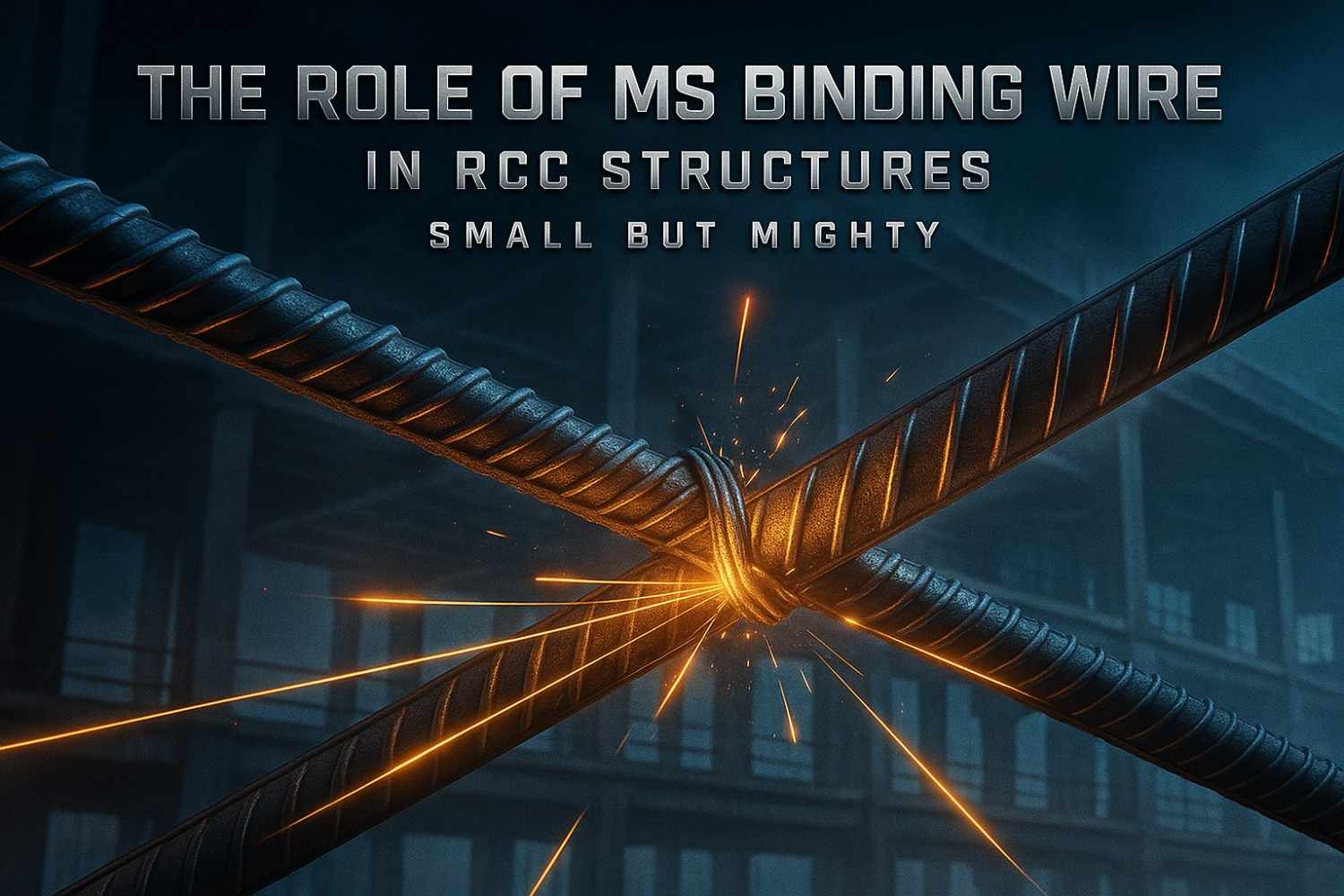
In the world of construction, steel bars often get the spotlight – and rightly so. But beneath every well-aligned rebar cage, there’s an unsung hero holding it all together: MS binding wire.
Light, flexible, and barely noticeable at first glance, this slender wire plays a mighty role in RCC (Reinforced Cement Concrete) frameworks. If you’re someone who’s planning a residential build, managing a commercial project, or even just trying to understand what keeps a slab’s skeleton intact, this blog is your go-to guide.
Let’s break down what binding wire for construction really does, how to choose the right type, and why it’s so essential – even in mega-scale projects using top-grade TMT bars.
A Real Project Snapshot: What Happened in Jaipur
Earlier this year, a mid-rise residential project in Jaipur faced an unexpected delay. The rebar cages for columns were tied using a lower-quality binding wire sourced from a local vendor. Within days, the site engineers noticed loose joints, uneven cover blocks, and displacement in the vertical bars.
The issue? The wire wasn’t ductile enough, and its gauge was inconsistent – resulting in weak ties that couldn’t hold the TMT bars in place during shuttering and concrete pouring.
Eventually, the team replaced the entire stock with SG Strong Binding Wire from APL Apollo SG, known for its consistency, strength, and smooth tying capability. The difference was immediate – not just in performance, but also in site efficiency.
What is MS Binding Wire?
MS (Mild Steel) Binding Wire is a soft, ductile wire used to tie reinforcement bars (TMT bars) together at joints so that they stay in the correct position during the construction of RCC structures like slabs, beams, columns, and foundations.
Made from low-carbon steel, it offers high flexibility and is available in multiple gauges depending on usage and tying needs.
Explore our full range of binding wire for construction
Key Features of High-Quality Binding Wire
Here’s what separates average binding wire from construction-grade wire trusted by engineers:
✅ Ductility & Bendability:
Good wire bends easily without snapping – critical during fast-paced tying work.
✅ Consistent Gauge:
Whether you’re using 16 gauge or 18 gauge wire, consistency in thickness ensures uniformity in joint strength.
✅ Smooth Finish:
Reduces damage to gloves and makes tying easier during extended use.
✅ Sufficient Coil Weight:
Available typically in 20–30 kg bundles, it ensures minimum wastage and optimal handling on site.
Binding Wire Uses in Construction
You’ll find binding wire wherever TMT bars go. Its applications include:
- Tying intersecting rebars in slabs, beams, and columns
- Holding steel cages in footings or pile caps
- Securing spacing bars to maintain design clear cover
- Fixing stirrups to longitudinal bars
- Bundling rebars for pre-shipping or movement
It may weigh less than a kilo per tie, but over the span of a high-rise structure, MS binding wire ensures that thousands of kilograms of TMT bars are held in perfect alignment before concrete is poured.
Choosing the Right Gauge & Weight
Common sizes include:
- 16 gauge (approx. 1.58 mm) – popular for most RCC work
- 18 gauge (approx. 1.22 mm) – lighter work like fixing cover blocks
The wire is sold in coils, and standard binding wire weight per coil ranges between 20 to 30 kg depending on the manufacturer.
🛠 Tip: For slab and beam work, always go with a wire that’s soft enough to twist manually but strong enough to hold rebars without slipping.
Why APL Apollo SG Strong Binding Wire Stands Out
When tying rebars using Fe 500D or Fe 550 grade TMT bars (especially from APL Apollo SG TMT), you need a wire that matches that standard of durability.
APL Apollo’s SG Strong Binding Wire is manufactured under stringent quality control, ensuring:
- Uniform diameter and smooth finish
- Enhanced ductility for faster tying
- Compatibility with high-tensile rebars
- Economical use with minimal wastage
✔ Made with low carbon content, it’s optimized for binding wire uses in construction across residential, commercial, and infrastructure projects.
Price vs Performance: A Note on Costing
You may come across a lot of fluctuation in binding wire price, often based on the following:
- Raw material rates (mild steel)
- Wire gauge and coil size
- Quantity purchased
- Manufacturer reputation
Reminder: Don’t fall for “cheapest per kg” offers. Focus on value. Poor-quality wire results in slower tying, more wastage, and rework if joints fail during RCC pour.
Interconnected: Binding Wire & TMT Bars
The best TMT bars deserve the best ties.
We’ve discussed previously how APL Apollo SG TMT Bars (available in Fe 500 and Fe 550) offer high tensile strength and bendability. But these properties are only effective if your binding wire holds the cage in place during and after concrete placement.
✅ Read: Common Mistakes to Avoid When Purchasing TMT Bars → “don’t just check TMT bar specs -ask about binding wire too”
✅ Also Read: How TMT Bars Are Tested → “high-tensile rebars deserve strong ties”
Final Thought: Small Inputs, Big Outcomes
In construction, attention to detail defines the difference between average and exceptional.
MS Binding Wire might seem like a small input—often an afterthought in material procurement – but it plays a critical role in ensuring structure stability. From low-rise homes to commercial blocks, from site workers to project managers, everyone benefits when the reinforcement stays where it should.
So next time you’re sourcing construction materials, don’t just check the TMT bar specs. Ask about the binding wire too.
Because when steel holds steel, quality is non-negotiable.
📘 Coming Up Next:
“Why Ductility Matters: The Science Behind Fe 500D and Fe 550D in Seismic Zones”





